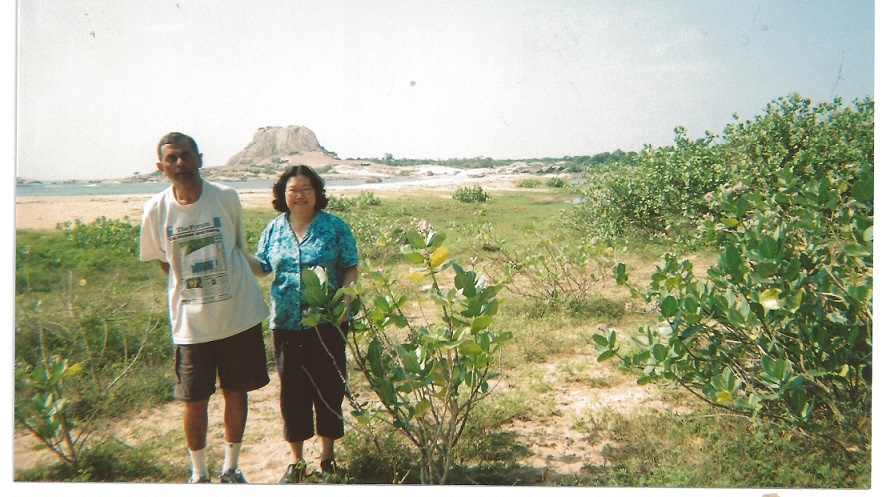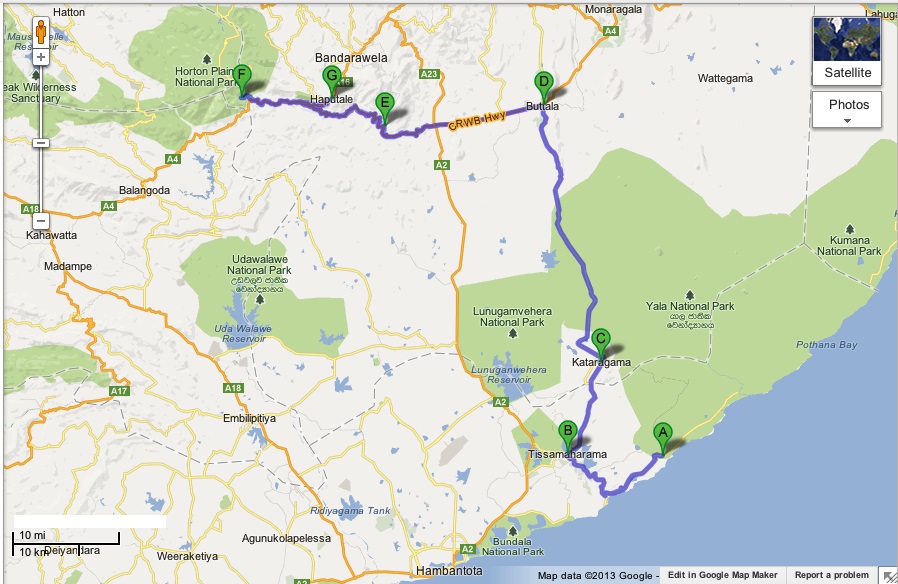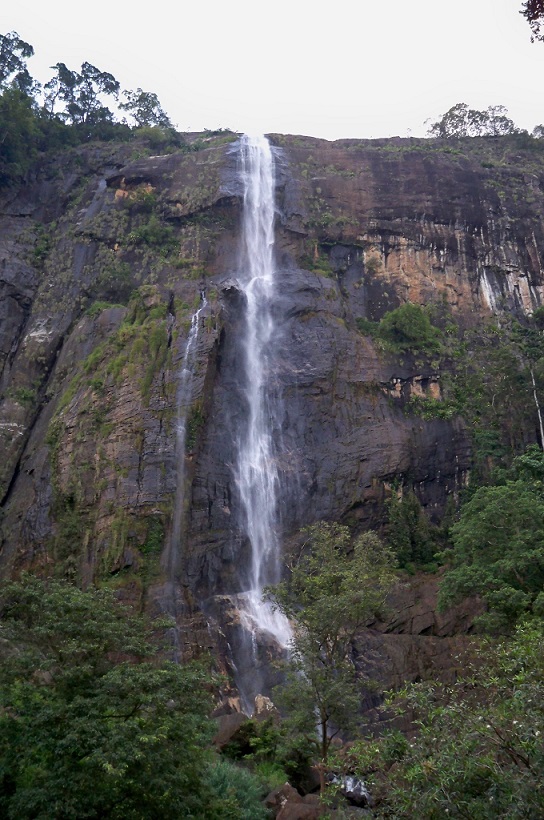Travels of a journalistâ€â€ÂÂThe Yala Adventure: SRI LANKA REPLACES NEED WITH GREED AT ALL TOURIST ATTRACTIONSâ€â€ÂÂSTEEP ENTRY FEES FOR EXPATRIATES TOO
Posted on May 23rd, 2013
By Shelton Gunaratne, author of From Village Boy to Global Citizen (Vol. 2): The Travels of a Journalist (Bloomington, IN: Xlibris).
On my island wide tour of Sri Lanka last month (April), I was taken aback by the official ticket checkersƒÆ’‚¢ƒ¢-¡‚¬ƒ¢-¾‚¢ insistence at some tourist attractions that I should pay the incredibly high entry fees of a foreigner. ƒÆ’-¡ƒ”š‚ I told them in rustic Sinhala that I was born and raised in the village ofƒÆ’-¡ƒ”š‚ ƒÆ’-¡ƒ”š‚ Pathegama in the korale of Weligama, but they insisted that I show them my passport to prove my nationality.
I, Weligama Podda of yoreƒÆ’‚¢ƒ¢-¡‚¬ƒ¢¢”š¬‚now carrying an American passport, was not ready to give in to their piranha-like instinct to grab my greenbacks. ƒÆ’-¡ƒ”š‚ Foreigners have to pay a $25-to $30 fee for admission, which is more or less Rs. 3,100ƒÆ’‚¢ƒ¢-¡‚¬ƒ¢¢”š¬‚a lot of money in local terms. I reasoned that the ƒÆ’‚¢ƒ¢-¡‚¬ƒ…-piranhasƒÆ’‚¢ƒ¢-¡‚¬ƒ”š‚ should recognize my birthrights as a native son and spare me the foreign tourist treatment.
Having got a taste for exploring the famous U.S. national parks such as Yosemite, Sequoia, Olympia, Yellowstone and Big Bend, my spouse Yoke- Sim and I agreed that we should have a taste of the 979 sq. km Yala National Park, one of Sri LankaƒÆ’‚¢ƒ¢-¡‚¬ƒ¢-¾‚¢s two oldest parks set up as wildlife sanctuaries in 1900 and designated national parks in 1938. So, we spent the night of the first Tuesday of April at the cozy Lake View Cottage on the northeastern edge of Tissa Lake in Punchi Akurugoda, Tissamaharama.
Our driver, Amal, told us that our rental vehicle would not fit the rough gravel roads in Yala. He said we would have to hire a tracker and a jeep to do our safari at an extra cost of Rs. 4,800 (about $ 39) in addition to the park admission fee of Rs. 3, 822 (about $ 30).ƒÆ’-¡ƒ”š‚ The hotel, which charged us Rs. 5,000 (about $ 40) for the nightƒÆ’‚¢ƒ¢-¡‚¬ƒ¢-¾‚¢s accommodation, made the necessary arrangements for the tracker to pick us up at dawn Wednesday.
The tracker showed up at 6 a.m., and we took off on the jeep to the Palatupana
VisitorsƒÆ’‚¢ƒ¢-¡‚¬ƒ¢-¾‚¢ Center and main entrance to the Yala NP, also known as the Ruhuna NP, munching on the takeaway Spartan breakfast the hotel gave us.ƒÆ’-¡ƒ”š‚ The tracker, a go-getter type, bought the admission tickets for my wife (who is a foreigner) at the tourist rate and for me at the local rate. Even though the total cost of visiting Yala seemed reasonable with this concession, I would have considered it a waste of money if the park had enforced the tourist rate on me as well.
I wasnƒÆ’‚¢ƒ¢-¡‚¬ƒ¢-¾‚¢t pleased with the Wildlife Conservation DepartmentƒÆ’‚¢ƒ¢-¡‚¬ƒ¢-¾‚¢s neglect of the network of roads within the Yala NP or with the facilities the visitorsƒÆ’‚¢ƒ¢-¡‚¬ƒ¢-¾‚¢ center provided. The department could easily convert the center to an educational tool through a combination of documentaries and printed literature, including maps. None in our party knew much about Yala or its contiguous neighboring national parksƒÆ’‚¢ƒ¢-¡‚¬ƒ¢¢”š¬‚Kumana NP to the east, Lunugamvehera NP to the west, and the small Bundala NP to the southeast; or its extended armsƒÆ’‚¢ƒ¢-¡‚¬ƒ¢¢”š¬‚Gal Oya NP to the north, Horton Plains NP to the northwest, and Udawalawe NP further west.
Although Yala claims to have 44 species of mammals, including some 35 leopards and more than 300 elephants, they kept on eluding the humans on safari for at least the first hour of tracking. We came to the park so early because everyone thought it was the most likely time that the wild animals came out to roam around for the pleasure of the inquisitive humans. But the fact was that three of the parkƒÆ’‚¢ƒ¢-¡‚¬ƒ¢-¾‚¢s five blocs were closed to the public. The trackers were confined primarily to Bloc 1 of the park to do their job.ƒÆ’-¡ƒ”š‚ No wonder that only a few animals came to greet the meddlesome humans in the open bloc when they could keep their privacy in the closed three!
The unkempt network of roads was unworthy even for jeeps. The trackers were driving their jeeps with tourists in all directions but failed to track any of the rare speciesƒÆ’‚¢ƒ¢-¡‚¬ƒ¢¢”š¬‚e.g., elephants, leopards, bears, boars, sambar, spotted deer, and othersƒÆ’‚¢ƒ¢-¡‚¬ƒ¢¢”š¬‚for quite some time. And then, voila! The gawkers were thrilled to see a sloth bear crossing the road, and to look at a herd of scattered elephants at very close range. One elephantƒÆ’‚¢ƒ¢-¡‚¬ƒ¢-¾‚¢s extended trunk almost touched my body that I, seated on the elevated front seat of the jeep, cringed in mortal fear of my life. Riding on the jeep, we also saw plenty of water buffalo, crocodiles, and monitor lizards.
Among the other mammals that Yala accommodates are the toque macaque, golden palm civet, red slender loris, and fishing cat. The parkƒÆ’‚¢ƒ¢-¡‚¬ƒ¢-¾‚¢s 215 species of birds include grey hornbill, wood pigeon, jungle fowl, barbet, babbler and bul-bul. The water birds we saw included cormorants, herons, storks, egrets, pelicans, and ducks. Yala also happens to be one of Sri LankaƒÆ’‚¢ƒ¢-¡‚¬ƒ¢-¾‚¢s 70 important bird areas (IBAs). The reptiles inhabiting Yala include the krait, keel back, flying snake, cobra, and crocodile.
The 2004 tsunami caused damage to 19 sq. km of the YalaƒÆ’‚¢ƒ¢-¡‚¬ƒ¢-¾‚¢s grassland, forest and wetland. Our tracker dropped us at a scenic spot facing Patanangala, a rock outcrop on the Indian Ocean beach, perhaps to contemplate the tsunami. By noon, he brought us back to the hotel in time for us to check out. He gave us an unsolicited demonstration of his driving skills when he drove his jeep at breakneck speed mistaking the narrow stretch of road from the park entrance to the hotel as his personal expressway.
After a light lunch, our driver took us to Kataragama, along the Tissamaharama Road, about 43 km to the north of Yala NP entrance. I could faintly recall my childhood visit to this sacred city on the banks of Menik Ganga, to invoke the blessings of the Kataragama Deviyo (also called Skanda Murukan) in the company of my mother and sister. I had to stop there again with my spouse on this occasion as well to seek the godƒÆ’‚¢ƒ¢-¡‚¬ƒ¢-¾‚¢s blessings and do the traditional walk to the Kiri Vehera.
Then, we drove 46 km further north on Sella Kataragama Road to Buttala. This stretch of the highway cuts through the border that separates the Yala NP and the Lunugamvehera NP. If tourists want to see herds of wild elephants freely roaming around without having to pay high safari fees, a drive on this road would do it! The road is well carpeted too.
Our destination for the night was Haputale (pop. 54,989)|, 60 km west of Buttala. As we made our way through the winding road to the islandƒÆ’‚¢ƒ¢-¡‚¬ƒ¢-¾‚¢s magnificent hill country in the Uva Province, we stopped by to admire the two tallest waterfalls in Sri Lanka: the 220 m Diyaluma Falls in Koslanda, and the 263 m Bambarakanda Falls in Kalupahana.



May 24th, 2013 at 7:23 pm
I agree with the writer with the lack of facilities in our main tourist destinations like Sigiriya, Yala, Anuradhapura etc. But why whinge about the different rates for locals and tourist.Although the writer was born in Sri Lanka, he is a foreign citizen now and should have paid the foreign tourist rate.When I travel in Europe I have to pay to use public toilets. I do not mind paying the foreign tourist rate, but I too think there should be decent facilities in these sites.But one can not expect to pay the local rates and expect all those facilities the writer wants.
May 25th, 2013 at 9:41 am
Fleecing the foreigners is not the answer to improving the facilities.
When the diference between the local and foreign prices are sky-high, visitors from other developing countries will feel the pinch much more than those from the affluent West. Besides no human being likes to be fleeced in this fashion just because the locals cannot afford to bear the burden of maintaining them.
The SL officialdom must respect the inalienable birth rights of the expatriates. They send billions of dollars to their motherland and visit it more often than the true foreigners thereby giving more hard currency to enable the ruling class to gallivant all over the world.
The psychology of fleecing is discouraging foreigners from visiting or returning to the various attractions. It is easy for people like Sarath W. to dismiss the opposition to fleecing as “whingeing.” Ask the piranhas who man the ticket booths to be lenient on SL expatriates and those from developing countries to accept their claims for what they are.
May 27th, 2013 at 6:15 am
I enjoy your writing. I myself toured Lanka and found a population explosion and loss of green areas.
June 13th, 2013 at 5:19 pm
I agree with the concept that if one is charged a sky high price then I expect high standards. When we visited the museum in colombo,one of the officers opened the toilet for my daughter who is severely disabled. The toilet was amazingly clean and excellent.
wish more sri lankan toilets were disabled friendly,especially with so many disabled victims of war